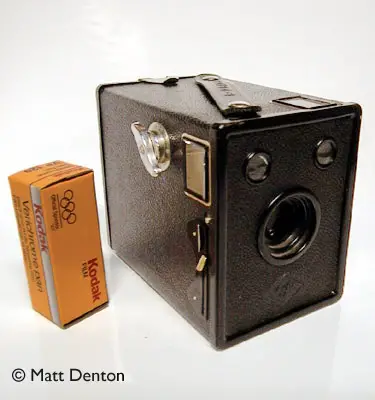- Produced 1937-1938? Agfa Ansco Corp, Binghamton, NY USA
- Film type B2 (120) rollfilm
- Picture size 6×9
- Weight 14.4oz (408.2g)
- Lens single element meniscus (looks like a big contact lens)
- Focal range assume 2m to infinity for most box cameras
- Shutter simple spring w/sliding aperture disc
- Shutter speeds one speed, about 1/60, plus ‘time’
- Viewfinder two ground glass screens (reflectors are polished steel)
- Exposure meter none
Overview
I’m thinking that I like box cameras after all. You can’t get much more basic, it’s essentially a cardboard box with a very simple shutter and lens. This one has only one shutter speed, ‘instant’, about 1/60 I’m told. (I don’t really consider the ‘time’ setting a shutter speed…it’s essentially the same as a ‘B’ setting). Two viewfinders – one for portrait and one for landscape, to change formats you just rotate the box in your hands. It doesn’t get much simpler than that! The single-element lens seems to be somewhat of a wide angle (compared to, say a TLR), making it ideal for architectural shots or landscapes.
When I first saw this little black box I thought ‘oh, it’s beautiful!’, then I thought, ‘oh no, the lens is missing!’ Then I remembered reading that it’s a common misconception on some old cameras where the lens is behind the shutter. This means the lens is always protected, which is nice, actually. I put the film box in the picture for scale – I always pictured box cameras as MUCH bigger (and perhaps some are) but this one is so small and cute you wouldn’t believe it. It’s about the size of two point-and-shoots stacked on top of each other (and takes better pictures than some I’ve used!)
This camera says ‘made in USA’ inside the door so I assume it was made in Binghamton, NY, after AGFA took over Ansco and dropped the Ansco name altogether (they were calling themselves Agfa-Ansco for a while). It has many design similarities to the earlier and more sophisticated Shur Shot. It also has a sticker that says ‘use Agfa B2 Plenachrome’ which I assume was color film, and there’s no reason I can see not to use color film in this camera, I just haven’t. In the Ansco page linked below, color film was used with very nice results.
Note – Agfa-Ansco made box cameras in both D6 (116) and B2 (120) format, and it’s hard to tell the difference unless you see it say D6 or B2 somewhere on the camera. You can almost tell by the proportions though…the D6 models are taller to accommodate the wider aspect ratio of 6.5 x 11, which looks closer to the aspect ratio of a 35mm neg than the more square B2 models whose aspect ratio is 6×9.
Repairs
Wiped down the exterior with a damp paper towel, then popped off the front plate and cleaned all the glass and the steel reflectors with Windex. Since the lens is behind the shutter I couldn’t get to it easily to clean it sufficiently with a Q-tip, so I went in from the back and popped out the single-element meniscus lens which was held in by just a snap ring (an angled dental pick is good for this) and made it pretty with a Kimwipe.
This little camera is in such good shape you’d think I bought it new last week. Even the leather handle barely has a crack. There’s a little black tape around the red window, some amateur leather repair apparently, but it looks tight so I’ll leave it be. Eyeballing the shutter spring I think it might not have the same tension in both directions, but the pictures on the test roll look pretty evenly exposed so I guess it’s ok.
Tips & Tricks
Special note – this shutter is not spring-return (like on the Shur Shot), but clicks down for one exposure, then takes another when you click the lever back up. Use a slow film like Plus-X or Ilford HP4 and shoot in daylight. Unless you’re trying to get candids, that is – I haven’t tried to shoot fast film and pull it back, but that might work. 125 ASA in daylight seems to be about right on this camera.
IN FACT, you wouldn’t think it, but a box camera makes a perfect stealth candid camera – not only is the shutter almost completely silent, people have no idea what it is that you’re holding. They think it’s a radio or something and pay it little attention. You can even sight it sideways for more mystery.
This is strictly a handheld camera; there is no tripod mount, no strap lugs, just a cute little handle on top, and takes a little practice to hold steady (you’re supposed to brace it against your body and hold your breath when releasing the shutter). This is the only major practical drawback in my opinion – what do you do with it when you’re not using it? There’s no everready case, no shoulder strap, you’re pretty much obligated to handhold the thing for the duration. I have seen some with leather cases (they look like a purse, that’s another story), but they tend to be all-enclosing and are essentially Neverready cases.
Loading film: don’t forget that you need to pull out the film wind knob before you can get the ‘cone’ out. You’ll know which way the cone goes by the extra hole for the winder.
Related Links
- Classic Camera has a very similar Ansco, with an impressive sample photo
- Box Camera 101 – a must
- An insider’s view of Agfa-Ansco (PDF) from one who lived it, the late Ira Current. Fascinating…
